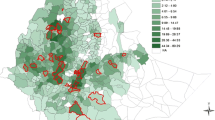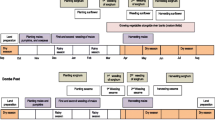Abstract
This paper explores the interrelationship between maize farming, the discourse of modernity, and the performance of a modern farmer in southern Zambia. The post-colonial Zambian government discursively constructed maize as a vehicle for expanding economic modernization into rural Zambia and undoing the colonial government’s urban modernization bias. The pressures of neo-liberal reform have changed this discursive construction in ways that constitute maize as an obstacle to sustained food security in southern Zambia. Despite this discursive change, maize continues to occupy a central position in the farming systems of the region. I argue that the continued prevalence of maize in southern Zambia can be understood as a performance that allows farmers to maintain their identities as modern rural subjects. The paper concludes with the policy implications of the field of performance on two contemporary debates in Zambian food security: the use of GMO crops and the promotion of cassava as a drought tolerant alternative to maize.
Similar content being viewed by others
Abbreviations
- MCBs:
-
maize control boards
References
ABC News (2002). Zambia rejects GMO maize. November 13, 2002. Retrieved from http://www.abc.net.au/pm/stories/s726176.htm on May 5, 2005
Brelsford W. V. (ed.) (1960). Handbook to the Federation of Rhodesia and Nyasaland. Published for the Federal Information Department. London, United Kingdom: Cassell and Company Ltd
Central Statistical Office (2003). Agriculture Analytical Report. Lusaka, Zambia: Republic of Zambia
Charles N., M. Kerr (1986). Eating properly: The family and state benefit. Sociology 20: 412–429
Cliggett L. (2005). Grains from Grass: Aging, Gender, and Famine in Rural Africa. Ithaca, NY: Cornell University Press
Chizuni J. (1994). Food polices and food security in Zambia. Nordic Journal of African Studies 3(1): 46–51
Colonial Office (1946). Colonial Reports Northern Rhodesia 1946. Lusaka, Northern Rhodesia: The Government Printer
Colonial Office (1951). Colonial Reports Northern Rhodesia 1951. Lusaka, Northern Rhodesia: The Government Printer
Copans J. (1983). The Sahelian drought: Social sciences and the political economy of underdevelopment. In K. Hewitt (ed.), Interpretations of Calamity: From the Viewpoint of Human Ecology (pp. 83–97). London, UK: Allen and Unwin.
Douglas M. (1966). Purity and Danger. New York, NY: Praeger
Duncan J. (1980). The superorganic in American cultural geography. Annals of the Association of American Geographers 79(2): 181–198
Escobar A. (1995). Encountering Development: The Making and Unmaking of the Third World. Princeton, NJ: Princeton University Press.
FEWS (Famine Early Warning System) (2002). Zambian food crisis to stretch beyond March. Retrieved from http://www.fews.org on December 23, 2002
Ferguson J. (1999). Expectations of Modernity. Berkeley, CA: University of California Press.
Franke R. W., B. H. Chasin (1980). Seeds of Famine: Ecological Destruction and the Development Dilemma in West Africa Sahel. Montclair, New Jersey: Allenheld and Osman.
Freidberg S. (2004). French Beans and Food Scares: Culture and Commerce in an Anxious Age. Oxford, UK: Oxford University Press
Goodman D., M. Redclift (1991). Refashioning Nature: Food, Ecology, and Culture. London, UK: Routledge
Haggblade S. and B. Zulu (2003). “Conference Paper No. 9: The recent cassava surge in Zambia and Malawi.” Paper presented at the InWEnt/IFPRI/NEPAD/CTA conference, Successes in African Agriculture, December 1–3, 2003. Pretoria, South Africa
Kapungwe A. (2005). Household food security and nutritional status in Zambia: Policy challenges. African Insight 35: 36–43.
Levi-Strauss C. (1965). Le triangle culinaire. L’Arc 26: 19–29
Marter, A. (1978). “Cassava or maize: A comparative study of the economics of production and market potential of cassava and maize in Zambia.” University of Zambia working paper
McCann J. (2005). Maize and Grace: Africa’s Encounter with a New World Crop 1500–2000. Cambridge, MA: Harvard University Press
Ministry of Agriculture and Co-Operatives (2004). National Agricultural Policy: 2004–2015. Lusaka, Zambia: Republic of Zambia Press
Miracle M. (1966). Maize in Tropical Africa. Madison, WI: University of Wisconsin Press
Mitchell D. (1996). In The Lie of the Land: Migrant Workers and the California Landscape. Minneapolis, MN: University of Minnesota Press
Mintz S. (1986). Sweetness and Power: The Place of Sugar in Modern History. New York, NY: Penguin Books.
Office of Development and Planning (1966). First National Development Plan 1966–1970. Lusaka, Zambia: Republic of Zambia
Richards A. (1932). Hunger and Work in a Savage Tribe. London, UK: Geo. Routledge and Sons Ltd.
Sen A. (1981). Poverty and Famines: An Essay of Entitlements and Deprivation. Oxford, UK: Oxford University Press.
Schein L. (1999). Performing modernity. Cultural Anthropology 14(3): 361–395
Watson J., M. Caldwell (eds.) (2005). The Cultural Politics of Food and Eating: A Reader. Malden, MA: Blackwell Publishing
Watts M. (1983). Silent Violence: Food, Famine and Peasantry in Northern Nigeria. Berkeley, CA: University of California Press
Woods A. (ed.) (1990). The Dynamics of Agricultural Policy and Reform in Zambia. Ames, IA: Iowa State University Press
Author information
Authors and Affiliations
Corresponding author
Additional information
Nicholas Sitko is a doctoral student in the geography department at the University of Colorado. His research interests include multi-disciplinary approaches to food studies, critical development, and Sub-Saharan Africa. This paper presents initial findings from field work conducted in Zambia in 2006. His dissertation research will further develop the relationship between neo-liberalism, food security, and agricultural production by employing analytical concepts derived from political-economic and cultural studies.
Rights and permissions
About this article
Cite this article
Sitko, N. Maize, food insecurity, and the field of performance in southern Zambia. Agric Hum Values 25, 3–11 (2008). https://doi.org/10.1007/s10460-007-9075-z
Received:
Accepted:
Published:
Issue Date:
DOI: https://doi.org/10.1007/s10460-007-9075-z




